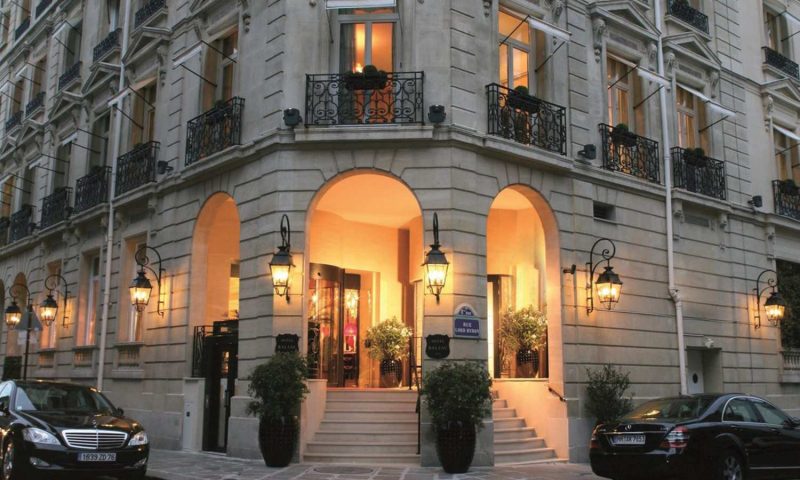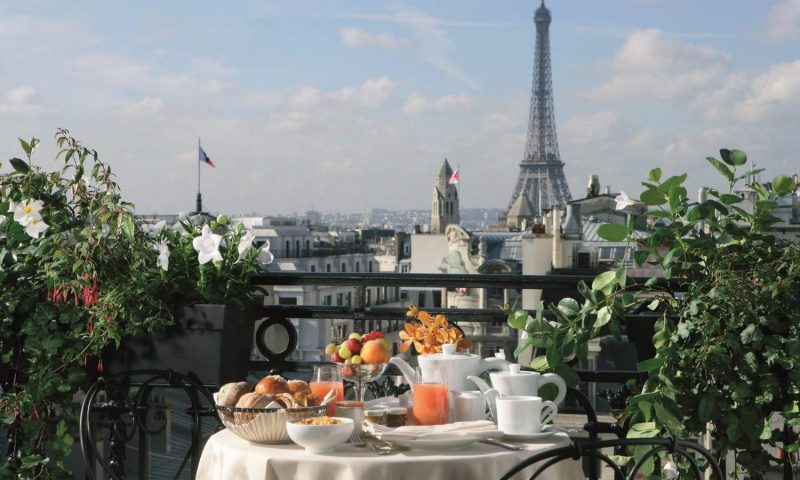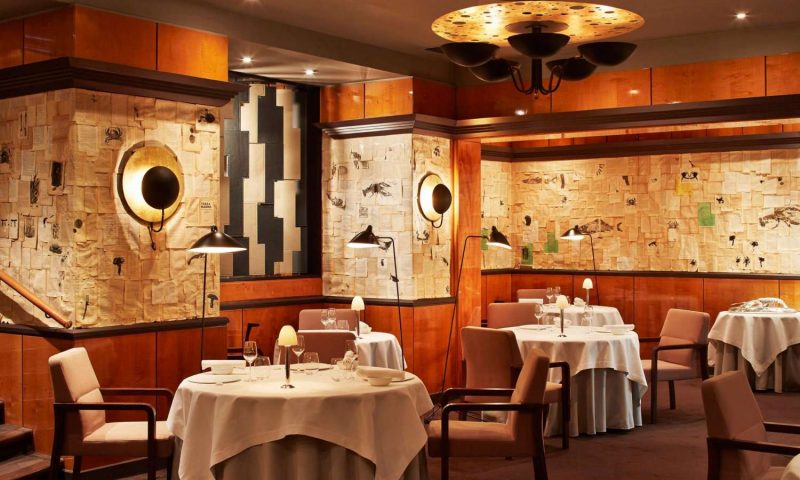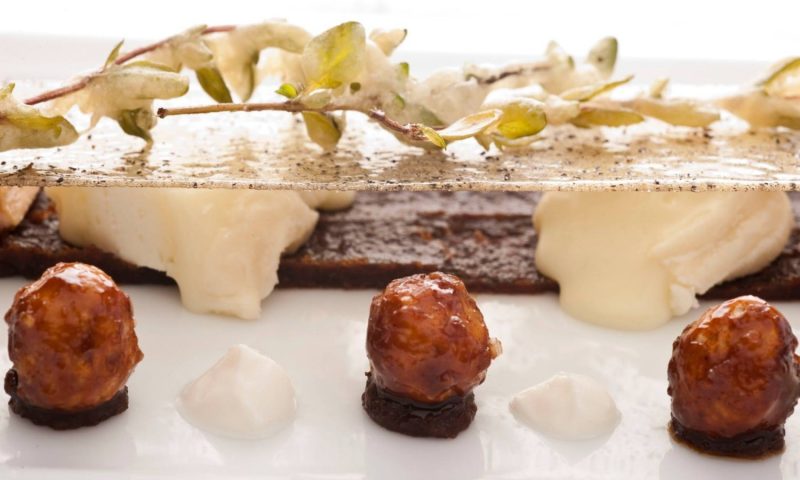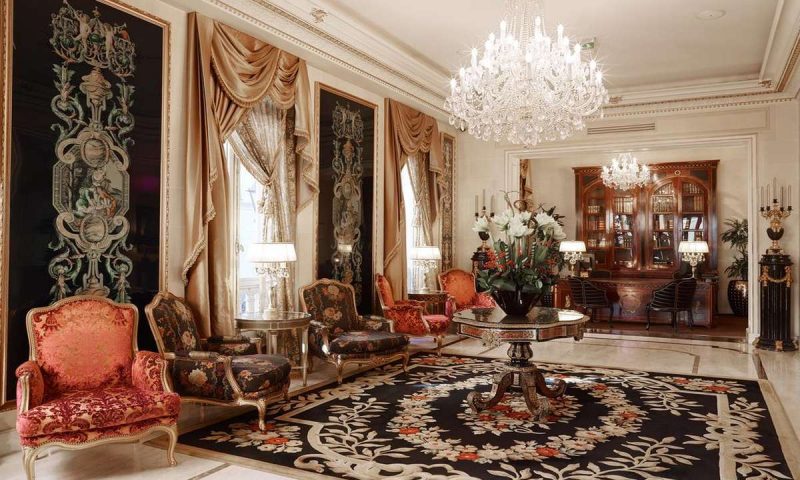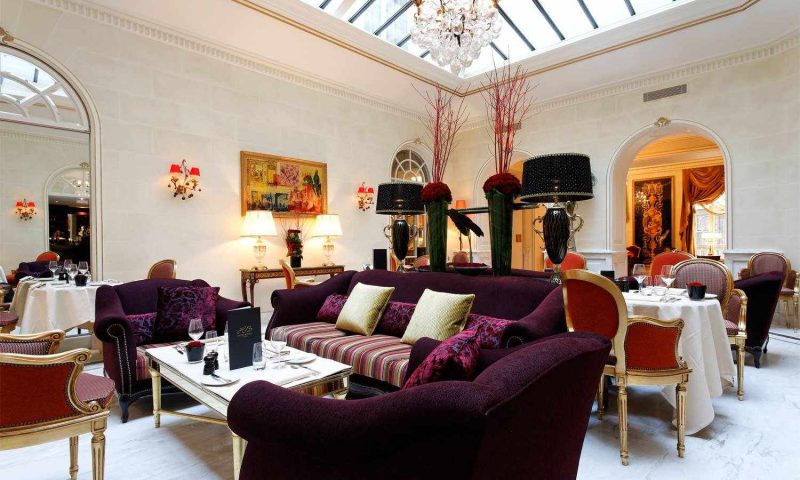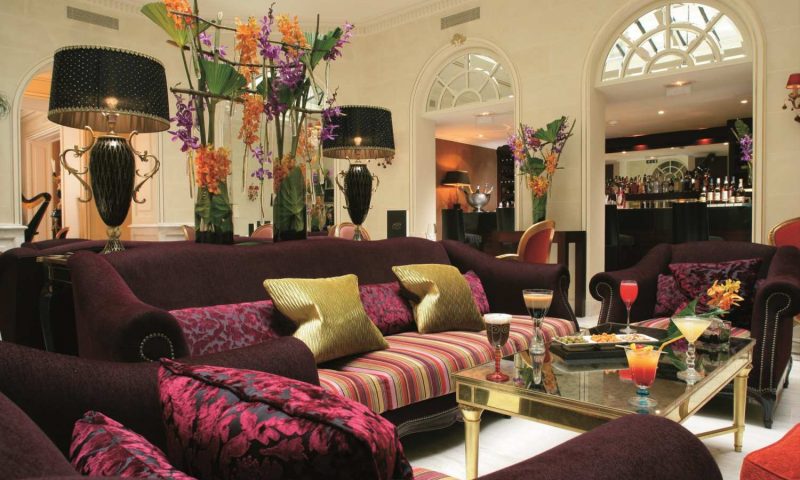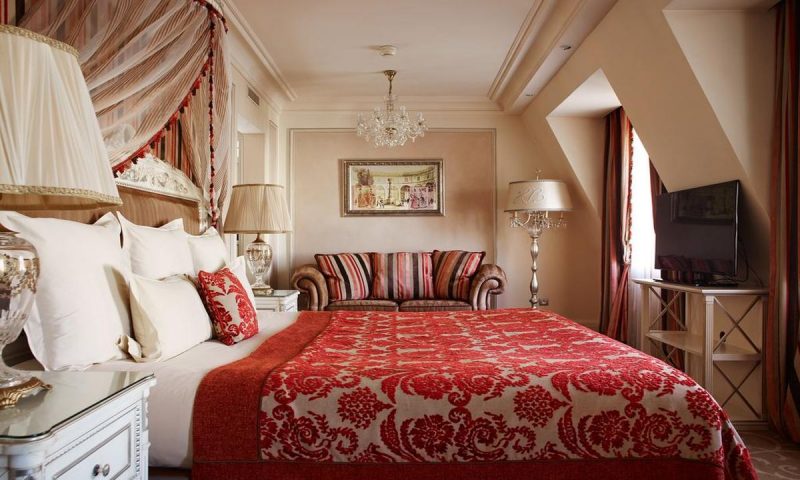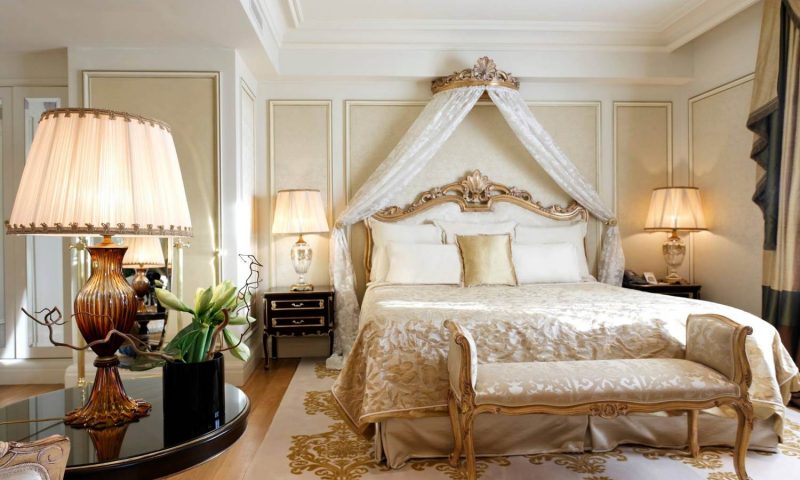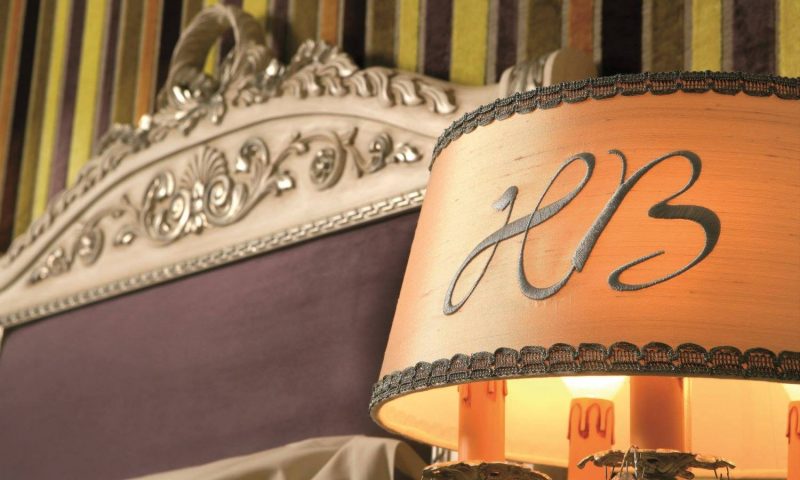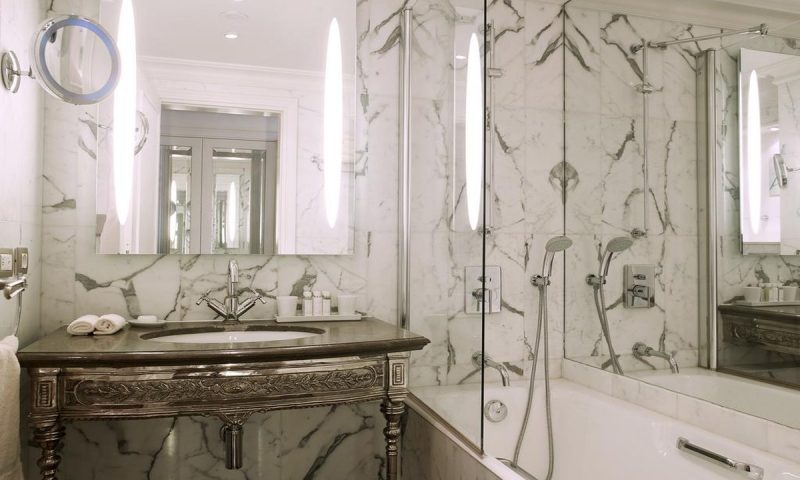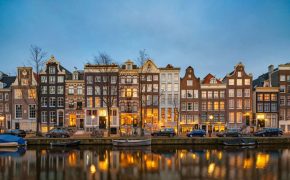Just off the Champs-Elysées and close to the Arc de Triomphe, Hotel Balzac Paris is one of the most outstanding deluxe boutique hotels in Paris’ 8th arrondissement.
Moments from both Avenue Montaigne and Avenue George V, the luxury five-star hotel sits grandly on the famous Rue Balzac and is perfectly located for the very best Paris has to offer.
Built for the director of the Paris Opera in the 19th century, the hotel boasts a rich history and has been immortalised in fiction by a selection of the world’s finest writers.
Completed at the turn of the 19th century it has served as an exotic private residence, a salon for epicureans and Champagne lovers… and was even owned by the great novelist Honoré de Balzac – who spent his final days there. A haven of peace and a shining example of Parisian chic, the luxury Paris hotel, is a blend of the elegant and the modern.
The 13 suites and 56 rooms at the hotel are sublimely decorated by Anne-Marie Sabatier, and mix a neo-classical style with rich colours, fabrics and contemporary furnishings. Some of the rooms, including the Royal Suite, exhibit stunning views of the Eiffel Tower and across Paris.
Hotel Balzac has been home to the world renowned chef, Pierre Gagnaire, for the past fifteen years. Here the flagship restaurant bearing his name serves up three Michelin Star modern French cuisine, and is recognised as the standard bearer for iconic, fusion cooking the world over.
Travelling to the hotel could not be simpler: it is just 40 minutes from Roissy Charles de Gaulle International Airport; two minutes from George V or Charles de Gaulles Etoile Metro stations; and just three stops on the RER from Gare du Nord and the Eurostar trains to London. Hotel Balzac is a taste of classic Paris that simply cannot be bettered.
Hotel Balzac: in the Beginning
The history of luxury Hotel Balzac reads like a novel. In the beginning of the 19th century, French banker Nicolas Beaujon commissioned the architect Nicolas-Claude Girardin to create a ‘folie’ for him on the considerable land attached to his principal residence.
The result was a pleasure palace built at the intersection of the present day rue Beaujon and rue Balzac and known as ‘La Folie Beaujon’. This ‘folie’ was regarded by contemporaries as extraordinary and was built in an exotic style with a large central pavilion anchoring four attached apartments.
After Nicolas Beaujon’s death, this well-known establishment evolved and changed hands several times before becoming home to a ‘salon’ for epicureans and champagne lovers. It was around this time that the legendary French writer took a fancy to the property.
The Spirit of Honoré de Balzac
Regarded as one of the founders of realism, Honoré de Balzac was a noted French novelist, playwright and short story writer… most famous for his collective works of La Comedie humaine, a panoramic look at French life between the Restoration and the July Monarchy (1815 – 1848).
After a sickly and fairly dismal childhood, Balzac arrived in Paris with his family and spent two years under private tutelage before entering the Sorbonne, where he studied under future Prime Minister Francois Guizot, classicist Abel-Francois Villemain and Victor Cousin, the famous philosopher.
On completing his education, the future author spent three years as a law clerk before announcing his intention to become a writer. For the next ten years, Balzac honed his craft as an author.
Though some of his writings bore faint hallmarks of his later works, this was a learning phase. He wrote mainly under pseudonyms, creating strange stories, trashy novels and titillating potboilers.
Shortly after he eventually began to publish work under his own name, Balzac hit upon the idea for his masterwork, La Comedie humaine… and for the next 20 years his individually published novels, plays and short stories painted a complex portrait of French society, which were eventually combined into one expansive masterpiece
Over the years his writing has influenced a litany of , including the novelists Marcel Proust, Émile Zola, Charles Dickens, Gustave Flaubert, Marie Corelli, Henry James, Jack Kerouac, and Italo Calvino as well as important philosophers such as Friedrich Engels.
It was towards the end of his career that Honoré de Balzac became enchanted with the future hotel, and in 1846 he acquired the property to give to Countess Ewelina Hanska, who he married in May 1850. He spent his last days in the house and died without ever having paid the purchase price.
Balzac’s spirit lives on in the luxury hotel where collections of antique books as well as lithographs depicting the writer, and scenes from his work can be found.
Location
Perfectly located in the 8th Arrondissement, right next to Paris’ fashionable Golden Triangle, Hotel Balzac puts you at the very heart of this vibrant, stylish city… making this luxury boutique hotel the ideal base to explore all the stunning sights and attractions that Paris has to offer.
Positioned just off the Champs-Elysées and a stone’s throw from the Arc de Triomphe, Hotel Balzac also offers easy access to the famous Avenue Montaigne and Avenue George V… both of which are just a short two minute walk from the hotel.
Stunning museums, such as the Louvre and the Musée d’Orsay are within easy walking distance and can be reached in under 25 minutes… as can the impressive Grand Palais and it’s wealth of stunning art and exhibitions.
Guests visiting Paris for business will be able to reach the bustling business centre la Défense in under 15 minutes by subway; and the hotel is also pleased to offer state of the art meeting room facilities should you need them.
In addition, Hotel Balzac is just 40 minutes from Charles de Gaulle International Airport; two minutes from George V or Charles de Gaulle Etoile Metro stations… and a mere three stops on the RER from Gare du Nord and the Eurostar terminal.
Rooms & Suites
The 57 rooms and 12 suites and at Hotel Balzac are decorated using refined colour combinations. The sublime tones, soft lighting, luxurious materials and state-of-the-art technologies (LCD televisions, cable TV, DVD player (on request), Internet access make each room and suite at Hotel Balzac in Paris an exceptional setting.
Some of our rooms have romantic skyline views of the Eiffel Tower, available by special request only.
Views of the Eiffel Tower and Paris
The Royal Suite has a terrace with a stunning view of the Eiffel Tower and Paris, while the adjacent Presidential Suite is appreciated for its warm, intimate decor.
Breathtaking Paris Rooftop Penthouse
Those who really want to have it all can reserve the entire luxury top floor and have use of both the Hotel Balzac Royal and Presidential suites. Together the combined Royal suite and Presidential suite offer 3 bedrooms, dining room and a large terrace, for an unforgettable experience.
Disabled Friendly Facilities
Hotel Balzac features 3 disabled friendly rooms for one or two guests and specific equipments (on request) such as phone, alarm clock, TV remote and wheel chair.
Royal Suite
The expansive Royal Suite of Hotel Balzac overlooks the Eifel Tower and the majestic Paris rooftops, offering you one of the most stunning views in the city. The suite is decorated in warm, vibrant tones that offer up an intimate atmosphere of old-world charm and opulence, and truly fitting of its Royal moniker.
Boasting a generous terrace, the suite also features a large sitting room and dining area. There is also the option of opening up an adjoining room to offer up two double bedrooms. The luxurious bathroom features a double sink, large bath and separate walk-in shower.
Presidential Suite
Warm, expansive and elegantly decorated in traditional Parisian style, the Hotel Balzac Presidential Suite is as impressive as it is beautiful. Located on the top floor of the hotel, the suite gazes out across the distinctive Paris rooftops, and is decorated with vibrant tones and traditional décor.
Boasting rich oak floors, the suite accommodates up to three adults and features both a large dining and sitting room, individual bedroom and a grand entrance hall. The luxurious bathroom of the Presidential Suite offers up a double sink, expansive bath and a separate walk-in shower.
Suites
Featuring extensive natural light, large sitting rooms, dining areas, separate bedrooms and state-of-the-art technology, the suites at Hotel Balzac are perfect for those looking for an elegant stay in the city.
Boasting stunning décor and period furnishings, the suites offer an immaculate taste of traditional Parisian luxury, and five-star hospitality at its finest.
In addition, the suites come equipped with opulent marble bathrooms featuring stunning bathtubs and separate walk-in showers. A selection of the corner suites also offer interconnecting Deluxe rooms, making space to welcome up to five adults.
Junior Suites
Offering superb city views, the Hotel Balzac Junior suites accommodate up to three adults in outstanding luxury. All suites feature exquisite wood floor entrance ways leading to expansive sitting rooms boasting immaculate soft furnishings and traditional décor.
In addition, they all offer well-proportioned dressing rooms, and stunning marble bathrooms featuring elegant bathtubs and separate walk-in showers.
Superior Rooms
All Superior rooms are equipped with state-of-the-art technology and come complete with luxurious marble bathrooms. All rooms overlook Hotel Balzac’s inner courtyard and benefit from a calm, quiet location.
Pierre Gagnaire – 3 Michelin Starred Restaurant in Paris
Pierre Gagnaire at Hotel Balzac: Innovation, Passion & Quality. “Tourné vers demain mais soucieux d’hier”.
Hotel Balzac has long been home to the world renowned chef, Pierre Gagnaire. This flagship restaurant, specialising in modern French cuisine, is recognised as a standard bearer for iconic, fusion cooking the world over.
Chef Pierre Gagnaire describes the ethos behind his successful vision as: Tourné vers demain mais soucieux d’hier (Facing tomorrow but respectful of yesterday).
And it is this combination of embracing the future, whilst giving a hearty nod to the past that delivers the innovation, passion and quality which is so closely associated with the master chef.
After cutting his teeth under some of the finest chefs in the business, Pierre Gagnaire struck out on his own in the town of St Etienne. It was here that his illustrious career really began to take off – and where he won his first collection of three Michelin Stars.
Since then he has overseen the development of a number of restaurants the world over… each of which stay true to the defining ethos of quality and innovation synonymous with Chef Gagnaire.
Alongside the venture at Hotel Balzac, his services and expertise as a head chef are devoted to:Sketch in London, Gaya in Paris, Pierre Gagnaire Pour les Airelles in Courchevel, Twist at the Manderin Oriental in Las Vegas, Pierre Gagnaire A Seoul in Seoul, Reflets in Dubai, Pierre Gagnaire – Tokyo in Tokyo, Les Menus in Moscow and Pierre in Hong Kong,
Pierre Gagnaire has been based at the luxury Paris hotel, Hotel Balzac, for the last fifteen years. In the time he has been based at our luxury hotel, Chef Gagnaire has remained on the cutting edge of contemporary cuisine… his dedication to the craft and the quality of delivery have ensured that the tables in his restaurant are never empty.
Due to this popular demand we recommend that you make a booking as early as possible to avoid disappointment.
Lounge Bar
The dining and drawing room areas of the Hotel Balzac restaurant and bar are lit with natural light that pours in from the glass ceilinged atrium, behind which a beautiful hanging garden forms the backdrop.
The atmosphere is elegant and intimate… and is complimented perfectly by its long black granite bar, high stools, dark velvet upholstery and soft lighting. The Lounge Bar is furnished with floral compositions and plum-coloured sofas.
This exclusive atmosphere makes the lounge bar at luxury Hotel Balzac Paris a perfect place to meet for breakfast, lunch, supper or even a cocktail… any day of the week, from 7 am to 11 pm.
Luxury Seminar & Meeting Room
One VIP conference and meeting room is available at Hotel Balzac Paris which can accommodate between 6 and 10 guests or delegates.
Elegant, comfortable and equipped with state-of-the-art technologies including Wi-Fi Internet access, large flat sreen TV, the Byron Meeting Room was designed to provide an exceptional setting for business meetings.
Located at the top of the Champs-Elysées, the Hotel Balzac is a 19th century mansion which has in recent years undergone a multi-million refurbishment program. This establishes this luxury property in Paris Champs-Elysées as one of the most exceptional landmark hotels in Paris.
Guests arriving at Hotel Balzac Paris will discover an elegant neo-classic decor with vibrant and warm colour schemes.
The Louvre
As French artist Paul Cezanne once advised, “Keep good company – that is, go to the Louvre.” Not only artists, but people from all walks of life, find delight and wonder time and again in this extraordinary centre for the arts in Paris.
Cezanne also referred to this world-renowned gallery as “a book in which we learn to read” – little did he know his own works would one day adorn the walls of the gallery, inspiring and teaching visitors along with other greats such as Da Vinci, Van Gogh, Michelangelo and Caravaggio, to name but a few. Cezanne’s recommendation – to soak up knowledge from this rich institution – is something that every visitor will identify with as soon as they enter the Louvre’s walls.
A Long and Colourful History
Set alongside the picturesque Seine River in the 1st arrondissement of Paris, the Louvre is easily accessed by the numerous metro stations nearby, such as the Louvre – Rivoli and Palais Royale – Musée du Louvre.
The history of the Louvre is as fascinating as the collections it houses, with the site of the original fortress rooted back in the 12th century – the foundations of this castle can still be seen in the basement level of the gallery.
In the 17th century, the Louvre palace was home to the flamboyant Louis XIV before he moved the French court to the newly-built, extravagant palace at Versailles, just outside of Paris, which can also still be visited today.
When Louis left, the Louvre became the site of his extensive royal art collection, added to by Napoleon, Louis XVIII and Charles X over the following century.
By the 20th century, war was spreading across Europe and all but a few artworks were removed from the Louvre and sent to a chateau in the Loire Valley for safety, only returning to Paris once France was liberated in 1945. Today it is home to more than 380,000 historic objects and 35,000 works of art.
Planning Your Visit
Annually receiving around 10 million visitors, the Louvre houses some of the most famous, celebrated, controversial and historically significant artworks in the world.
Because of its vast size, the museum provides guests with maps in 13 languages and daily guided tours to help navigate the vast 60,600 square metre museum.
Collections are clearly divided into eight colour-coded key areas: Egyptian Antiquities, Near Eastern Antiquities, Greek, Etruscan, and Roman Antiquities, Islamic Art, Sculpture, Decorative Arts and Paintings.
Rooms are numbered and there are orientation tables and panels installed in every room, using arrows to help guide you to the next section.
This layout makes it easy to explore the areas you’re really interested in or, for beginners, allows a logical, chronological introduction to an overview of the museum, so you can really learn about the progression of art movements through time.
As you approach the museum on arrival, the most striking aspect that you’ll notice is the contrast between old and new created by the grand, Renaissance architecture of the palace and the modern glass pyramid entrance, built in 1989.
This prominent and controversial addition is now the feature by which the Louvre is most famously recognised – since completing the museum, attendance has doubled. The outdoor area around the pyramid is known as the cour carrée and is decorated with soothing fountains and public benches.
This square opens up onto the Jardin des Tuileries, a huge expanse of garden stretching alongside the Seine where visitors can eat lunch and enjoy the sun in summer months.
Once inside, you’ll be met with the inverted pyramid – a similar structure to the one above ground but this time pointing downwards into the foyer. This much glass, allows the entrance to be flooded in natural light so the pale marble floors and walls are illuminated, creating a hospitable welcome to the museum.
What Not to Miss
Arguably the most famous painting housed at the Louvre, if not worldwide, is Leonardo Da Vinci’s Mona Lisa. This painting has its own dedicated exhibition area and is easy to spot as it will have a constant throng of eager visitors assembled around it.
Still, it’s worth waiting your turn to get a glimpse of the artwork with your own eyes – you may be taken aback by how small it is, but its power over the beholder is certainly great.
The portrait’s origins are shrouded in mystery, from the true subject in the painting, to the background scenery and, of course, whether the eyes really do follow you around the room.
Giving this piece a few minutes of your time to just soak up the unusual colours and to decipher what emotions the subject may be hiding is definitely worthwhile.
The Mona Lisa
Alongside the Mona Lisa, there are plenty of other famous and beautiful artworks to be explored in the gallery. The Venus de Milo – one of the most famous Ancient Greek sculptures created between 130 and 100 BC – has its home here.
Originally found in a cave on the Greek island of Milos by a local farmer in 1820, this statue is famous for its lost arms, one of which is thought to originally have clutched an apple.
Other works that mustn’t be missed include the Diana of Versailles statue, Death of the Virgin by Caravaggio and Michelangelo’s The Dying Slave. If you’re an art fan, however long you are in Paris, you must build a visit to this unparalleled gallery into your trip.
Whether you stay for an hour or the whole day, there is no chance you will regret time spent at this dedicated monument full of world history and culture – take away astonishing memories that will stay with you for many years to come.
Palais de la Découverte
Under the Grand Palais’s awe-inspiring nave of glass and steel, a venue is attracting visitors from all around the world: the Palais de la Découverte – Paris’ science museum. When you walk through its vast, spherical hall, you will be stunned by the immensity and beauty of the place.
The white, stone statues that ornate the roof depict mythological tales, whilst an intricate mosaic draws a soft-hued, rose pattern on the floor.
It’s only after taking the marbled stairs to the first floor that the classical architecture changes to a more modern style… on this storey, visitors can look forward to experimenting with mathematics, physics and chemistry like never before.
Renowned for its culture and architectural wonders, France is also land of science. From Marie and Pierre Curie’s pioneering research on radioactivity to Louis Pasteur’s vaccination and pasteurisation, French scientists have led the way to some of the world’s most important discoveries.
These discoveries are ready to be explored through playful and educative workshops in the Palais des Découverte…
Paradise For Adults and Kids Alike
The Palais de la Découverte gives guests the options of entering a machine to make hair stand on end to understand static electricity, as well as discovering how the brain and the olfactory system are related with diverse smelling tests.
Through varied tasks built for every age, the museum explains science to both kids and adults – you’ll understand how progress was made in major fields such as medicine, geology, biology and mathematics.
Most importantly, guests will learn how these advancements have come to have an indispensable place in everyone’s daily life.
For younger visitors, they can discover how volcanos and seismic shocks work in the “Séismes et volcans” exhibition where each step of a volcanic eruption and its consequences are shown, whilst older ones can attend a fun class in the maths department and (finally) understand more about Pythagore, Thalès and π.
At the end of the workshops, all generations will be glad to meet in the temporary expo room where dinosaur, sea and jungle worlds collide to reveal their secrets…
Heightening Visitors’ Awareness of Current Issues
More than a classic museum, the venue also aims to alert people to issues our planet is encountering – climate change being the main one.
Through four huge signs, video interviews with experts and an interactive quiz for everyone to test their knowledge on the topic, visitors will learn more about its impacts on Earth, its direct consequences and long term effects.
Seizing the opportunity offered by the Cop 21 (the international summary on Climate Change held in Paris in 2015), the Palais de la Découverte shows a detailed analysis of how global warming is happening, leading youngsters and adults to realise its imminence and how fast they need to act against it, offering handy tips and hints to make small but vital changes in everyday life.
Whether you’re a born science enthusiast or feel like you’re more of a literary lover, the Palais de la Découverte will catch your attention and seduce you with its accessible expertise and educative activities.
If you want to continue exploring and discovering the amazing universe that surrounds us, you can head to the Cité de la Science, in the 18th arrondissement, and enjoy bigger exhibitions inside la Villette’s modern, glass structure. You’re guaranteed an outstanding stay in the City of Light – where you’ll never stop learning…
Louis Vuitton Foundation in Paris
With its innovative architecture, mixing glass with concrete, this contemporary monument opens its immense doors to exceptional art exhibitions and hosts some of the biggest cultural events in the city.
From Jean-Michel Basquiat’s colourful, engaging paintings to Nicolas Ghesquière’s Summer 15 show, the gallery, which was opened in 2014, has welcomed the work of some of the most famous artists in the world. Discover a temple of modern art in the heart of the Bois de Boulogne – just outside Paris.
An Iceberg Emerging from the Woods
The first thing you’ll notice when seeing this now world-renowned establishment from outside, is the unusualness of its architecture. Made from huge, sail-shaped glass panels and concrete squares, this amazing venue resembles a futuristic boat, sailing on a flat lake imitated by the pond at its feet.
This breath-taking creation is located in the heart of the vast Jardin d’Acclimatation, in the Bois de Boulogne, and cleverly blends modern design with nature.
Trees and grass grow in the centre, lending their beauty to the futuristic building for an even more magical feel. Slightly hidden, the white, clean lines of the Louis Vuitton Foundation – and its forest location – make the whole scene look like an immense iceberg emerging from the woods.
This extraordinary construction pushes the boundaries of conventional architecture and according to Frank Gehry, the man who designed it, it embodies a “magnificent vessel symbolising the cultural calling of France”.
A Temple of Modern Art
Once you’ve walked through the large doors of this extraordinary space for art and culture, you’ll discover that – besides being a work of art in itself – the Louis Vuitton Foundation also welcomes diverse, innovative exhibitions which decorate its 8,637 square meters space.
In the past, the venue has seen its interiors covered with Popist, an incredible show presenting the work of the most famous artists in the 20th century.
Some collections housed here have included: Andy Warhol’s printed paintings of daily objects, Jean-Michel Basquiat’s powerful creations adorned with the artists’ iconic crown, intriguing drawn faces and splashing colours, and Andreas Gursky’s point of view on urbanism through beautiful photos taken from the air, showing particularly colourful scenes.
A shout out about society, this exhibition has always aimed to gather daily products and images that are driven by television, advertising and the Internet since the advent of consumerist society.
A place that cherishes diversity, it has also presented many performances that allow visitors to interact with varied mediums. With its Music/Sound exhibition, the foundation has set up a show where music is integral to the work artists are presenting.
Imagine an expo where video is mixed with projections, installations, wall texts and soundtracks… This is art brought to life using all of the sense, not just sight, the get their strong messages across.
A House for Fashion
Founded in 1854, Louis Vuitton is one of the biggest names in the fashion industry – and the LV Foundation is now following in its footsteps. An impressive venue for any kind of event, the location has hosted the Louis Vuitton Summer ‘15 fashion show.
Nicolas Ghesquière, the brilliant artistic director of la maison Vuitton, adorns its interiors with huge screens where models’ faces were projected as they walked the runway.
The usually white rooms were darkened for the occasion – forcing the spectators to focus exclusively on the bright shades of orange and white that characterise the womenswear collection.
From exciting exhibitions to beautiful fashion shows, this wonderful location is as diverse and innovative as the varied events it presents. Get ready to discover an unbelievable gallery, a building that always keeps you guessing and exceptional performances all at once… and just minutes away from the centre of Paris.
Visit the Sumptuous Champs-Elysées
Let’s face it, when you think of Paris, the first things that come to mind are: a) romance, b), stunning sights and c), clothes shopping. With its cobbled, four-lane roadway, its Haussmannian-styled shops and its iconic monuments, the avenue des Champs Elysees is one of the few spots in the French capital that embody these three qualities all at once. Imagine yourself strolling down this immense boulevard, admiring Parisian attractions whilst browsing France’s finest brands…
Feeling like you want to know more of the place that has been (justly) named the “most beautiful avenue in the world”? We’re telling you all about how the Champs Elysees perfectly blends history with modernity – and why to make it your number one destination when landing in the city of Light, love and food.
Where History Meets Modernity
When walking down the vast avenue des Champs-Elysées, you’ll be taken aback by your historical surroundings. Picture the majestic Arc de Triomphe at the head of the street, overlooking the city with its impressive architecture and intricate sculptures.
Imagine the Concorde at its end, piercing the Parisian sky with its gold-tipped spike. Visualise the Grand Palais, further down by the Seine, both delicate and sturdy all at once, with its famous nave made of glass and its white limestone façade.
Built 1.2 miles long and 230 ft wide, the avenue is the French capital’s ultimate landmark. It was created to draw a huge, straight line into the heart of Paris; the “historical axis”.
This links the Arc de Triomphe, the Concorde and the Louvre together through a clever game of perspectives – allowing you to see them in perfect alignment wherever you’re standing along the famous thoroughfare.
As you stroll down this historic location, you’ll fall in love with the beauty of its monuments as well as with its more recent sites. More than a monumental, historical legacy, the Champs-Elysées is also attracting tourists from across the world for its exclusive shops and luxury venues.
Over the decades, it has seen its pavements and beautiful, Haussmann buildings welcome more and more restaurants, hotels and stores – this succeeded in modernising the neighbourhood without losing any of its grandeur.
Every venue embraces the street’s architecture for a wonderful blend of history and modernity, complementing, rather than transforming one another.
A Place for Shopping and Going Out
Now the wealthiest area in the city, this quartier will soon become your favourite location for enjoying Paris’s latest trends and best food.
Besides its world-renowned architecture and cuisine, the French capital is mostly famous for its elegant fashion. Chanel, Yves Saint Laurent, Dior, Louis Vuitton… Who can honestly say they haven’t thought of stepping (at least) a toe in one of these famousbrands’ magasins*? Certainly not us – and we don’t believe you if you deny it.
Parallel to the Champs-Elysées, the rue Montaigne offers the finest stores in terms of haute couture and ready-to-wear. Birch trees frame this exquisite street and shop windows are protected by gold-tipped, cast iron railings.
Enjoy a promenade, if not a shopping session, and head back to the main avenue to make your last purchases – the high street labels situated on the Champs-Elysées conveniently don’t close until 10pm.
After a few hours going through these stores’ amazing collections, stop by one of the fancy restaurants located on both sides of the Champs-Elysées. If you feel like playing the Parisian cliché card, choose The Fouquet’s and sit at a table where several French Presidents have eaten before you…
If you’re looking for a quiet yet exceptional venue, find your happy place atL’Epicerie, 30 rue de Miromesnil, for a real taste of Southern French cuisine – , delicious produce and even more sumptuous wines.
And to end a wonderful day, you can either watch the latest movies in the huge rooms of the UGC Normandie cinema, or attend a play at the Théâtre des Champs-Elysées…
As the famous French song goes “Il y a tout ce que vous voulez aux Champs-Elysées” (you’ll find anything you want, on the Champs-Elysées). From breath-taking monuments, to high-end fashion boutiques and amazing cuisine, it is sure to satisfy your urge for the finer things in Paris!
The Musée d’Orsay: A Celebration of French Artists in Paris
One of the most famous and beautiful museums in Paris is the recently-refurbished Musée d’Orsay. Housed in an ornate railway station from the turn of the 20th century, this museum specialises in French art.
Whilst the Louvre houses one of the largest collections of world art and the Pompidou Centre celebrates modern art post-1914, the Musée d’Orsay proudly boasts one of the largest collections of impressionist and post-impressionist masterpieces in the world.
Artwork at this museum comes from the decisive 1848 – 1914 period, a time that changed Europe forever. Works by celebrated French artists Degas, Monet, Cézanne and Renoir are amongst the collection in this authentically preserved fin de siècle building on the north bank of the River Seine. For those in search of a truly French experience from the Golden Age of art in France, the Musée d’Orsay must not be missed.
An Extraordinary Historic Building
Perched on the River Seine in the 6th arrondissement, the original railway building still looks as impressive today as it did when it was opened in 1900 for the Exposition Universelle – the World’s Fair.
The great length of the white limestone building and large, ornate windows flanking the sides still betray this structure as an early 20th century railway terminal. However, instead of busy platforms of jostling travellers, once you step inside, visitors are met with a very different scene.
The Original Railway Features are Still Preserved
The elaborate features of the station, such as the high vaulted ceiling and glass-panelled windows in the roof are preserved to allow natural light in to illuminate the main hall.
Recently, the station’s tilework has been beautifully restored and the gilded light fixtures that hang from the ceiling were renovated to their previously elegant condition.
The crowning glory of the entrance hall is the gilt, baroque-style clock which is visible from everywhere in the room and chimes the hour – another reminder of the building’s former function.
The main hall is mostly dedicated to sculpture. Since the recent refurbishment, new marble sections have been added to the sides of the room to divide the space into smaller antechambers, accommodating individual collections.
This has also extended the upper levels of the hall, meaning visitors can explore more artwork on the first floor mezzanine area. The main entrance remains open and airy with some of the most eye-catching sculptures by artists such as Paul Gauguin, Edgar Degas and Auguste Rodin lining the walkway.
There are many opportunities to sit on benches around the main hall for a quiet moment of reflection and to appreciate your surroundings. This room has a calm, respectful atmosphere, not dissimilar to that of a place of worship – this illustrates the relaxation and contemplation visitors find in this gallery.
A Different Delight in Each Room
Moving into the other areas of the museum, you will notice the recently painted rich, berry-coloured walls chosen to present the paintings. This choice of colours for the collections is a deliberate nod to the grandeur of the eras the gallery celebrates in its artworks – the Second Republic through to La Belle Époque.
By choosing opulent, lavish shades such as this, the museum showcases the artwork in an atmosphere similar to that of the original times these pieces were created.
Often enhanced by golden frames, the paintings in the Musée d’Orsay collections are mounted on these walls sparingly to allow plenty of space for guests to roam and take in the true beauty of the art – generous use of space and light is the common theme throughout this gallery.
The Ornate Golden Clock in Musée d’Orsay
Amongst the celebrated artworks you’ll recognise Renoir’s classic Bal du Moulin de la Galette, the famously complex scene of Parisian revellers and Starry Night Over the Rhone, the characteristically nocturnal piece by Van Gogh.
Helpful signs and leaflets, as well as guided tours and audioguides in a range of languages are available to visitors to navigate the museum so you don’t miss a thing. Compilations are grouped and displayed in an ever-evolving movement of artwork at the Musée d’Orsay.
Instead of permanent, rigid collections, the art is regularly rotated and themed in new creative ways, allowing visitors to view pieces in a different light each time they visit. Paintings on loan to other galleries worldwide are returned, just as other pieces are lent out in a constantly changing melange of art.
Enchanting Exhibitions of Europe 1848-1914
Alongside this fluid collection, exciting exhibitions are created for fixed periods – past displays have celebrated sculpture, painting, photography and historic objects.
Impressionism exhibitions are always popular and tend to focus on themes such as love, society and family, using nature and pastoral scenes to capture the ‘golden’ era they were created in.
Post-impressionist exhibits also intrigue visitors, rebelling against the earlier movement with their darker themes of poverty, dreams and death. The Musée d’Orsay captures a time of anticipation for the new century and immense industrial change in France and the wider world, between 1848 and 1914.
Exploring the paintings here offers more than other galleries, instead you are journeying through a key era in Europe, experiencing what life was like in a time that optimistically thought mankind was heading for prosperous times with the dawn of the 20th century.
This artwork is an insight into what life was like during this expectant chapter across Europe, before decades of unrest and war ravaged the continent. It is a fascinating collection, not to be missed by lovers of art and history alike.
Montmartre Cemetery: a Beautiful, Peaceful Memorial
With so many famous writers, artists, dancers, poets and actors hailing from Paris – or at least spending large parts of their lives there – it is hardly surprising that the city is home to some interesting and monumental graveyards.
Though it may sound macabre, exploring these cemeteries is a fascinating way to discover the layers of history that have turned Paris into the diverse and artistic centre of culture it is today.
Whilst Père Lachaise and Montparnasse might be larger cemeteries, Montmartre is a beautiful spot to wander, reading the tombstones and enjoying the calm and tranquillity of the area.
It is also in an ideal location – and just 20 minutes from Hotel Balzac – for exploring the rest of Montmartre, such as the vintage shops, museums and, of course, Sacré-Cœur basilica, perched on the hilltop overlooking the city.
18th Century Paris: A Grim Time
Life in Paris in the 18th century was not pleasant for most people – diseases spread quickly because of the cramped and unsanitary conditions, life expectancy was short and people were often too poor to afford proper funerals for their loved ones.
The cemeteries of Paris became overcrowded, with plots becoming too full to continue using – even with coffins stacked one on top of the others metres down into the ground, they were running out of space faster than they could dig new burial sites.
In the 1780s, the Cimetière des Innocents – the cemetery used for Parisians since the Middle Ages – was closed. This was the oldest and largest cemetery in Paris and mass graves had often been used to dispose of corpses with speed and efficiency.
Because of its overuse, many of the bodies had to be exhumed and taken to a new subterranean site, which was later covered over with the place Joachim-du-Bellay – a central Paris square near the modern-day Pompidou centre that still exists today.
A New Cemetery Opens
Montmartre Cemetery opened in 1825 in a disused quarry so was initially given the name la Cimetière des Grandes Carrières.
The quarry had already been used as a mass graveyard during the French Revolution so, since the site was abandoned, it proved a perfect space to continue burying their dead. The cemetery is below street level and accessible from Avenue Rachel.
This destination is popular with tourists visiting the area as it is the final resting place of many artists who resided in Montmartre. During the Belle Époque period – between 1871 and 1914 – there was a creative boom in Paris.
Many artists made Montmartre their home and the cafes and music halls here were full of the great minds and talents of the day – including Van Gogh, Gauguin, Renoir, Rousseau, Matisse, Picasso and Toulouse-Lautrec.
It is for this reason that the cemetery in Montmartre still draws the crowds today – this is less a resting place of politicians and military leaders, and more somewhere the bohemian and avant-garde were buried.
A Final Resting Place for Creatives
Whilst many of the famous artists who spent their lives in Montmartre have been laid to rest in their home towns, family plots or in grand cathedrals, there are still plenty of interesting graves to find in the cemetery here.
A map of the tombs, best routes to walk and visitor information about the people who were buried in Montmartre can be found here.
Naginski’s grave with statue on top
The celebrated ballet dancer, Vaslav Nijinsky has a beautiful tomb in the cemetery, topped with a bronze statue of the dancer dressed as the puppet character he played in Petrouchka.
Edgar Degas – the artist famous for his paintings and sculptures of ballerinas also rests here, as do composer Hector Berlioz, famous can-can dancer La Goulue and Adolphe Sax, the inventor of the saxophone.
From the literary world, Alexandre Dumas fils, whose father wrote The Three Musketeers and who forged a successful career as a dramatist himself can be found here.
Alfred de Vigny, the poet and novelist for whom one of our sister hotels is named after is also buried here, alongside German poet Heinrich Heine and Émile Zola, whose famous novels include Au Bonheur des Dames and Germinal.
Even if you don’t come to spot the famous graves, this site is still a beautiful and serene area to come for a leisurely stroll and escape the busy streets of the city. Some of the less well-known deceased actually have some of the most beautiful gravestones, sculptures and plants on their plots.
This is the ideal start to a day in Montmartre – afterwards, take a short walk to the hub of the bohemian district for a delicious lunch in one of the relaxed cafes. It’s likely you’ll find a spot where one of the famous people you have just left behind might have sat and written in themselves…
The Eiffel Tower
While the lattice framework of the Eiffel Tower will be instantly recognisable to most, the details of its fascinating history may be lesser known. Opened in 1889, the Art Nouveau structure has attracted almost 250 million visitors to date and has become the world’s most visited paid-entry monument.
It has gained a reputation for being one of the most romantic destinations for marriage proposals and an unmissable attraction for all ages in a city full-to-the-brim with some of the world’s most iconic landmarks, museums and galleries.
Its decorative arches are internationally admired with over 30 replicas as far away as Nevada and Tokyo, and it has played a key part in France’s scientific advances. Discover the story behind France’s very own ‘Iron Lady’ and plan your visit to this famous monument during your next stay at Hotel Balzac.
History
On the 31st of March 1889, Alexandre Gustave Eiffel climbed the 1,710 steps of his namesake tower. His aim was to tie France’s blue, white and red flag to its peak… a fitting inauguration for what would become the international symbol of his country.
This 324 metre tall monument was not the work of just one man though. The Journal Officiel launched a competition to ‘study the possibility of erecting an iron tower on the Champs-de-Mars’.
The structure would provide a grand entrance to the 10th Exposition Universelle, a world fair held to commemorate the 100th anniversary of the French Revolution.
There were 107 entries, and the winning design was created by Eiffel, engineers Maurice Koechlin and Emile Nouguier, alongside architect Stephen Sauvestre.
It took 50 engineers and designers, 150 factory workers and up to 300 onsite workers, two years, two months and five days to construct this feat in French engineering. While protesters described it as ‘the dishonour of Paris’, the majority of the city – and the world – adored the Eiffel Tower.
It attracted 12,000 visitors a day during the fair, which shouldn’t be surprising considering it was the world’s tallest man-made structure (which it remained for the next 41 years until New York’s Chrysler Building opened).
Scientific Advances
The Eiffel tower was only meant to remain dominating Paris’ skyline for 20 years, however Gustave Eiffel was keen to secure its future by finding a practical use for his creation.
He dedicated the final 30 years of his life to scientific experiments along its lace-like structure; from studying astronomy in his top-floor office, to building wind tunnels at its foot. The most significant, and fruitful, result of this work was related to building an aerial mast for wireless broadcasting.
The Eiffel Tower hosted the first radiophonic experiments and was used to intercept messages between Germany and Spain during the First World War.
By jamming German radio communications, the tower’s transmitters helped slow the advance of German soldiers at the First Battle of Marne in 1914, and also played a part in the arrest of the exotic-dancer-turned-spy, Mata Hari. The tower also went on to play a central part in the launch of French TV and now boasts 120 antennas.
Fascinating Facts & Sporting Feats
As one of the world’s most awe-inspiring and recognised monuments, the Eiffel Tower has attracted the attention of many leading artists, sports fanatics… and has also been the setting for many legendary stories.
For example, did you know that the tower was ‘sold’ twice for scrap metal by the notorious con artist, ‘Count’ Victor Lustig? Upon reading that the tower was in a state of disrepair in 1925, Lustig set up a meeting and successfully posed as a French government official keen to sell the tower due to ‘… engineering faults, costly repairs and political problems…’.
His first buyer was a business man keen to make a name for himself in Paris, who, once the truth came to light, chose not to press charges to save face. The authorities were alerted during his second attempt and Lustig fled to America.
It’s second floor was once home to the printing press of Le Figaro newspaper, while a gun was fired on the tower to signal noon on a daily basis until 1907, when a 20 foot giant clock was introduced.
It’s been featured in films such as 1957’s Funny Face, 1963’s Paris When it Sizzles and 2006’s The Da Vinci Code, as well as becoming the subject of paintings by the likes of Paul Signac, Marc Chagall and Robert Delaunay.
Jean Cocteau called it a ‘…beautiful giraffe in lace…’ and wrote a libretto that inspired a ballet called ‘Les Mariés de la Tour Eiffel’ that was first performed in 1921.
The Eiffel Tower’s height and its many stairs have also attracted the attention of many sports enthusiasts over the years. It’s been the site of bungee-jumps, parachuting and abseiling, while its stairs have been navigated via monocycle, wheelchair, and mountain and motocross bikes.
Its floors and base have hosted giant hopscotch, a golf tournament, a diving pool, a snow trail with ice bar…and there’s even been a 700 metre tightrope walk from the tower to the Palais de Chaillot.
The oldest elephant in the world managed to walk up to its first floor in 1948, while 227 competitors took part in a ‘Stair Climbing Championship’ held by newspaper ‘Le Sport’ in 1905.
Meanwhile, the future Mayor of Montmartre, Pierre Labric, cycled down the first floor stairs in 1923 in order to win a ‘cup’, which can now be found in the tower’s cellars…before being arrested by police waiting at the bottom.
From inspiring art to providing some of the most entertaining anecdotes in all of Paris, the Eiffel Tower boasts a truly fascinating history.
Visiting the Eiffel Tower
Visiting the Eiffel Tower couldn’t be easier during a stay at Hotel Balzac. Those keen to explore the city’s streets will be able to enjoy a 30 minute door-to-door stroll, while the nearest Metro and RER stations are Bir Hakeim, Trocadéro and Champ de Mars-Tour Eiffel.
Though open 365 days a year, just under seven million visitors flock here every year and pre-booking is advised. Lifts are available between the tower’s three floors, however, keen walkers may prefer to take the 704 step climb to the second floor and enjoy outstanding views through its lattice frame.
Alongside the chance to admire a panoramic of Paris, each floor also boasts its own array of attractions to explore. The first floor is home to a 300 capacity events space, a souvenir shop and Le 58 Tour Eiffel restaurant, where lunch can be served in a chic picnic basket.
It also offers a range of learning tools including touch screen displays and projections, as well as a specific section dedicated to children, where parents can pick up an activity booklet to entertain little ones. Finally, and perhaps, most importantly, its floor is entirely transparent… 57 metres above ground.
Meanwhile, the second floor offers the chance to see the city in a little more detail thanks to telescopes, and visitors can also opt to sample contemporary French fine-dining created by renowned chef Alain Ducasse at Le Jules Verne restaurant.
However, those seeking to toast to an extra special occasion may fancy a trip up to the Champagne Bar on the top floor. Snack shops selling salads, cakes, pastries and drinks can also be found on the ground, first and second floors, alongside the tower’s very own colourful macaron bar on the second floor.
Those seeking to find out more about the tower’s history may want to book a place on its two guided tours. The ‘Behind the Scenes’ tour offers exclusive access to specific areas normally out of bounds to the public, while the ‘Show Visit’ option will deliver an educational, theatrical love story performed by an actor.
Seasonal attractions include the stunning New Year’s fireworks, themed summer terraces and a sparkling ice rink in the winter, however one of its most magical moments happens every single night of the year. For five minutes on the hour, every hour from nightfall until 1am, the tower appears to sparkle.
This spectacle sees the tower bathed in golden light while 20,000 white light bulbs flash on and off to provide a glittering effect… and the result is utterly mesmerising.
Whether you’re keen to find out more about the history behind one of the world’s most admired architectural triumphs…or simply want to admire views over the capital, a visit to the Eiffel Tower is a must during a five-star stay in Paris.
Arc de Triomphe in Paris
If anything comes close to rivalling the Eiffel Tower as the emblem of France, it’s the Arc de Triomphe. But what the Arc lacks in height and notoriety compared to its wrought-iron neighbour, it more than makes up for in way of historical intrigue and national importance.
Here’s our guide to the world-famous monument, situated at the western end of the Champs-Elysées – just a scenic six-minute stroll from Hotel Balzac!
A Brief History of the Arc de Triomphe
Commissioned by Napoleon to commemorate the victory of the Grande Armée at Austerlitz (1805), the building of the Neoclassical, Roman Arch of Titus-inspired Arc de Triomphe would commence on the French Emperor’s birthday (15th August) in 1806.
Unfortunately for Napoleon however, the Corsican conqueror would not live to see his 50-metre tall war trophy completed, following his death in 1821.
As it happened, he would have had to survive for another 15 years to be present at the inauguration of the Arc in 1836, which in his unavoidable absence, was instead unveiled by King Louis-Philippe.
And it wasn’t just the deaths of the ruling classes which hampered the monument’s development. The initial brains behind the Arc – architect Jean Chalgrin – would be succeeded by his student Louis-Robert Goust, whose own work on the Arc de Triomphe would be halted by Napoleon’s abdication in 1814.
In fact, work on the structure wouldn’t resume until 1833; this time overseen by Louis-Philippe I and his architect Guillaume-Abel Blouet.
From Decorative Arch to Emblem of France
Today the Arc de Triomphe stands proudly at the centre of the Place Charles de Gaulle, forming a fundamental figure of Paris’ Axe Historique. But more than a mere arch, with time the Arc de Triomphe has emerged as a national symbol of France.
This is in part due to pivotal moments in French history; such as the Allied victory of 1918, following which, French soldiers would march beneath the iconic arch. Pilot Charles Godefroy would even go as far to fly his Nieuport fighter plane through the Arc de Triomphe – which surprisingly (or unsurprisingly, you decide) has found its way onto YouTube!
Though perhaps the most central to the Arc’s placing as an emblem of France, is with its housing of the Tomb of the Unknown Soldier beneath its vault. Here, a flame is famously lit every evening in memory of the unidentified dead from both World Wars.
Annually, on Armistice Day (11th November), a memorial service is also held at the foot of the Arc de Triomphe, attended by leading French figures, including the President.
Days of Discovery at the Arc de Triomphe
From the outside, hours can be spent marvelling at the intricate sculptures of the Arc de Triomphe: including The Triumph of 1810 (Jean-Pierre Cortot), Resistance and Peace (Antoine Étex) and the most renowned of them all, Departure of the Volunteers of 1792 by François Rude.
Venturing inside – up the 284 steps to the observation deck – however, will unveil an altogether different viewing experience, as you inhale stunning views over a patchwork of Paris roads and rooftops.
For the best views, visit at night to see illuminated landmarks like the Eiffel Tower in all their glory, while the rest of the capital twinkles below.
One level below the observation deck, you will also be able to trace the history of the Arc de Triomphe within a small museum, filled with a number of interesting and interactive exhibits!
